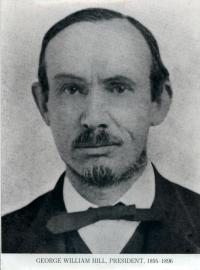1909
After earning a B.A. at Rutgers, G.W. Hill joined the staff of the Nautical Almanac Office in Cambridge, Massachusetts, in 1861. Shortly afterward he withdrew to his family’s farm in West Nyack, New York, where he preferred to work alone. Hill was one of the most respected mathematical astronomers of all time. He computed the orbit of the moon while making original contributions to the three body problem. He introduced infinite determinants, a concept which later found application in many fields of mathematics and physics. When Simon Newcomb took over the Nautical Almanac in 1877 and began a complete recomputation of all solar system motions, Hill was assigned the difficult problem of the orbits of Jupiter and Saturn. He reluctantly moved to Washington, where the Almanac Office was now located, completed the enormous labor in ten years, then returned to the farm, where he continued his research in celestial mechanics. He accepted a lectureship at Columbia University established especially for him (with a gift from Catherine W. Bruce), but soon resigned and returned his salary when few students enrolled in his course.
Presentation of Bruce medal
Burckhalter, Charles, PASP 21, 51-60 (1909).
Other awards
Royal Astronomical Society, Gold medal, 1887, presented by J.W.L. Glaisher, MNRAS 47, 203-220 (1887). See also Observatory 10, 114 (1906).
Royal Society, Copley Medal, 1909.
Some offices held
American Mathematical Society, President, 1895-96.
Biographical materials
Archibald, Raymond Clare, Semicentennial History of the American Mathematical Society, 1888&-1938 (American Mathematical Society, 1938), 117-24 [includes complete list of Hill’s publications].
Brown, E.W., Biographical Memoirs, National Academy of Sciences 8, 275-309 (1916).
Dick, Steven J. & Jordan D. Marché II, Biographical Encyclopedia of Astronomers (Springer, NY, 2007), pp. 506-07.
Eisele, Carolyn, Dictionary of Scientific Biography 6, 398-400.The MacTutor History of Mathematics archive
Moulton, Forrest Ray, “George William Hill,” Popular Astronomy 49, 305-11 (1941).
Rutgers University Hall of Distinguished Alumni
Schlesinger, Frank, “Recollections of George William Hill,” PASP 49, 4-12 (1937).
Schlesinger, Frank, “The Almost Forgotten Genius. Recollections of George William Hill ’59,” Rutgers Alumni Monthly 17, 3 (1938).
Tenn, Joseph S., “George W. Hill: The Eighth Bruce Medalist,” Mercury 20, 2, 52 (1991).
Obituaries
Brown, E.W., Proc. Royal Society of London A 91, 42-51 (1915).
Jackson, J., Observatory 37, 257-60 (1914).
Jeans, James, MNRAS 75, 258-64 (1915).
Moulton, Forrest Ray, Popular Astronomy 22, 391-400 (1914).
Woodward, R.S., Astronomical Journal 28, 161-62 (1914).
More obituaries
Portraits
Mary Lea Shane Archives of Lick Observatory, 1909 photo
U.S. Naval Observatory Library: painting by Beverly Stautz
Named after him
Lunar crater Hill
Minor Planet #1642 Hill
Hill Center for Mathematical Sciences, Rutgers University
George William Hill Professorship of Mathematics and Physics, Rutgers University
